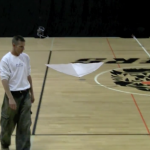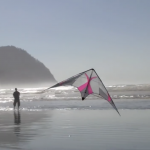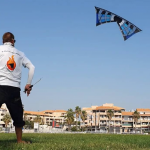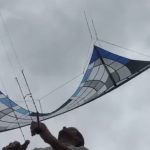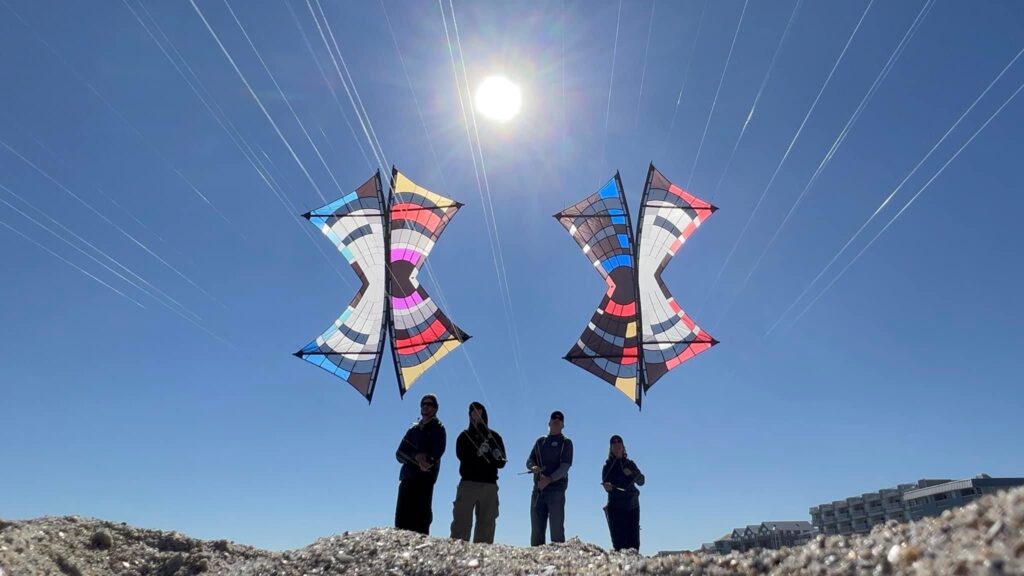Single Line Kites
Likely the most familiar to an average person, single line kites fly on one string (we call it a line) but the urban or indoor models that I prefer tend to be simpler in design with some maneuverability and long gliding ability… These characteristics make flying the kite very easy, so much so that elderly or physically limited individuals can still find freedom in flight.
Speaking strictly toward controllable single line kites, the basic principle for flying them has to do with pulling in (power/flight) and letting out line (turn/glide) while you fly, using subtle right and left inputs in combination with speed control to perform a variety of movements.
One of the major advantages of a good indoor / urban glider is that you can quite literally fly these kites just about anywhere… Your living room, office, hotel lobby or train station, glider kites have taken spontaneous guerrilla kite flying to a whole new level.
Indoor models tend to be super, super light to make up for the absence of wind, while urban gliders tend to be a little stronger (added weight) for variable winds and outdoor impacts, both can be used almost interchangeably if wind and skill allow.
Single Line Glider Example
Dual Line Kites
One of the two most common controllable or “stunt” kites, many of us remember these as basic diamond or pyramid (“delta”) shapes made with aluminum, fiberglass or other materials… When a dual line kite is launched in enough wind, it is a “nose forward” flier that responds to pushing or pilling on the right and left lines, steering the nose where you want while flying forward.
These days, with super light carbon frames and over 20 years of design evolution, dual line kites can still be flown elegantly but are definitely more apt to faster flight speed, more aggressive movements and rotational tricks – I always describe dual lines as the “electric guitar” of sport kites, full range but capable of some really dynamic and high-paced maneuvers both indoors and out.
When looking at dual lines, there are a couple of key approaches to selecting a kite…
First is “slack line” tricks, wherein the kite is partially unstable and can be laid on it’s back, rotated, flipped and rolled up in it’s own lines through an infinite variety of combinations that make the kite appear as if it’s a yo yo, and not really flying under power.
Second is precision, which generally comes down to being stable, with solid drive, cornering and very controllable oversteer, the far extreme of this might be described as “driving a truck”… Can’t trick, but it’ll fly a straight line and turn corners like nobody’s business.
Alas, after flying literally hundreds upon hundreds of dual line kites over 20+ years of development and technology advancement, I’ve found that most pilots tend to prefer either tricks or precision… I truly enjoy both, but getting the right balance of trick and precision is tricky and the kites I would personally consider true “all rounders” are few and far between.
Dual Line Kite Example
Quad Line Kites
If dual line kites are the electric guitar, then quad line kites, particularly those such as the Djinn and other similar styles, would be the equivalent of an electric saxophone… While they generally lack that “straight and true” forward drive and R/L steering, controlling the kite with four lines gives you the ability to affect any edge of the sail to make it fly in any direction.
Forward or reverse at any speed, sideways flight, pivot on a wing tip or rotate on dead center or hover mid-air in any orientation – a skilled pilot can very gently place one wing tip into a 1″ hole at over 100 feet away, or do a blazing dive at over 50 mph and stop on a dime without hitting the ground, all of which also makes quad line kites very popular for team flying.
The versatility of quad line kites gives them more fly time than my dual lines, but they both provide a very different flight sensation, I’ve learned a lot from the comparative experience and I couldn’t live with just one.
